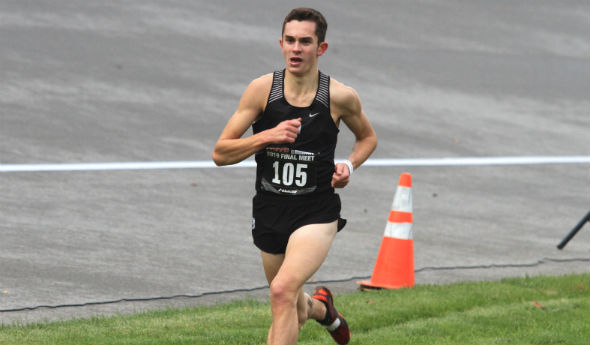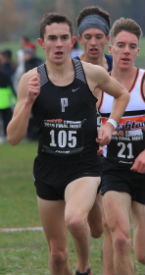
Performance: Plymouth's Carter Solomon
November 7, 2019
 Carter Solomon
Carter Solomon
Plymouth senior – Cross Country
Plymouth’s top runner the last three years capped his high school cross country career as the state’s best – and one of its fastest champions all-time. Solomon won the Lower Peninsula Division 1 championship Saturday at Michigan International Speedway in 15:01.2, the sixth-fastest 5K Finals time in state history, earning him the MHSAA “Performance of the Week.”
Solomon had finished 18th (and second among Plymouth runners) at the Finals as a freshman, then fifth as a sophomore and second as a junior before crossing the line first and five seconds ahead of the field in his last high school race at MIS. The win capped an unbeaten season for Solomon, and that’s no small achievement – not only is LP Division 1 generally the fastest annually in the state, but four more of the top seven runners at this year’s meet were from Solomon’s Kensington Lakes Activities Association. He also ran at invitationals against a number of other contenders from other divisions, including twice against Dearborn Divine Child’s Anthony and Michael Hancock, who finished second and third, respectively, in LP Division 2. Solomon’s season and personal-best 14:42.7 actually came at the Regional at Ann Arbor Huron, where he cleared the field by more than 31 seconds.
As a team, Plymouth finished 12th at the Finals after earning the championship in 2018 and finishing runner-up in 2017 – again, both times with Solomon in the lead. He also will help pace the track & field team one more season in the spring after finishing fourth in the 1,600 and ninth in the 3,200 at last year’s LPD1 Finals. Solomon will continue his running and academic careers next year at University of Notre Dame; he’s carrying a 4.0 grade-point average this school year and will study either mechanical or aerospace engineering.
Coach Jonathan Mikosz said: “Carter is one of those runners that you dream about being able to coach. Not many other coaches have ever had the opportunity to coach a better runner in this state. When you have a guy on your team of that caliber, I think it helps bring out the best in other guys as well. He was a huge part of our teams that were state champions and state runners-up back-to-back years. … In this day and age when people are hiring private coaches and looking at the internet for advice, it has been great that someone of his abilities has bought in 100 percent into our system and our coaching plan. He has bought in since day one and always trusted us as coaches. That's rare in this day and age, but him being so coachable has also (contributed) to his success. I couldn't be prouder of what he has been able to accomplish. … He has worked hard and has stayed humble with his success. That's one of the things I am most proud of. We have both learned a lot from each other. He will definitely be missed next season.”
Performance Point: “This weekend was awesome. I keep thinking about that race and everyone at the end and how it truly was an experience I will never forget. (It was) the last piece of the puzzle for my high school career. My season’s not quite over yet; I want to race at Foot Locker. The team title was awesome – I was happy for the team – but coming in second (individually last year) was a bummer and I knew I wanted to come back next year and win it and check off the team title and individual title boxes on my resume. Getting that done this year was truly awesome."

Providing the push: “I talk to the guys at other schools too; we talk about our races and what not. Having them there definitely is motivation, and I use that to push me while I am training. I have teammates too; Patrick Byrnes, he is a good training partner. I’m thankful for my competition.”
Ready to rock: “Before I even go to the meet, I will run around my neighborhood for a shake-out run, but that’s pretty common. I listen to music in my headphones. I have a playlist mixed with Foo Fighters, Korn, a little Metallica, your heavier metal classic rock kind of music.”
No place like home: “(My favorite course) is our home course, Cass Benton Park. I like it because everyone else hates it, People come in, ‘Oh, we have to race there …’ Well, you’re lucky you get to race it. It’s a tough course – it’s hilly, it’s long, it’s hard to mentally get through. But I’ve raced it so many times throughout my high school career, and even in middle school I raced it a couple of time. I’ve just grown to love it.”
Running is for me: “I think the feeling I get after accomplishing my goals is what I work for. Practice six days a week, training a long time and coming up short is demoralizing. But when you reach the goals you set for yourself, and you do the things you didn’t know were possible a couple of months before, I think that is really why I am addicted to it.”
Engineer it: “When I was young, I was curious about how things worked and taking stuff apart. My dad introduced engineering to me, and I joined the engineering program at our school my freshman year. We did a lot of cool stuff in the engineering field, trying to get an introduction to it, and I really like it.”
– Paige Winne, Second Half
Past honorees
Nov. 1: Jameson Goorman, Muskegon Western Michigan Christian soccer - Report
Oct. 24: Austin Plotkin, Brimley cross country - Report
Oct. 17: Jack Spamer, Brighton cross country - Report
Oct. 10: Kaylee Maat, Hudsonville volleyball - Report
Oct. 3: Emily Paupore, Negaunee cross country - Report
Sept. 26: Josh Mason, South Lyon soccer - Report
Sept. 19: Ariel Chang, Utica Eisenhower golf - Report
Sept. 12: Jordyn Shipps, DeWitt swimming - Report
PHOTOS: (Top) Plymouth's Carter Solomon races down the home stretch during Saturday's Division 1 Final at Michigan International Speedway. (Middle) Solomon leads a pack, including Brighton's Jack Spamer, earlier in the race. (Photos by Matt Yacoub/RunMichigan.com.)

MHSAA Vault: MIS Rose to Challenges to Host 2020 LP Finals
By
Rob Kaminski
MHSAA benchmarks editor
November 12, 2021
The “MHSAA Vault” features stories from past publications and other documents in the MHSAA Library. This issue takes a look at the MHSAA Cross Country Finals at Michigan International Speedway, which celebrated 25 years in 2020 – although it was an event that nearly didn’t happen last fall …
In 1996, the MHSAA and Michigan International Speedway began a partnership the changed the course of the Lower Peninsula Cross Country Finals – quite literally.
The land in and around the track at Brooklyn would host the Finals for all classes of runners in one place on one day, an annual festival of nearly 2,000 runners competing for the MHSAA’s top honors.
Even skeptics – and there were several among running purists who thought the course was too flat, for example – can’t deny the results.
Finals attendance nearly doubled in that first year, and crowds in excess of 10,000 have enjoyed a day of racing several times, including a record 12,153 in 2011.
Enthusiastic crowds were the norm in recent years, with 11,232 in 2017, and nearly 11,000 in 2018 (10,989) and 2019 (10,873).
In fact, attendance failed to reach at least 8,000 only twice since the move to MIS.
Of course, last year was an exception, when attendance was limited to 1,000 spectators per session due to the COVID-19 Pandemic. Fans also were restricted to the grandstands rather than following the action throughout locations on the course.
To reduce the number of runners in each race, the event was spread over two days, with each Division being run in two separate “sections” with times then combined at the end to determine team and individual champions.
While not ideal, the end result was another year of fantastic efforts at MIS – both from student-athletes and those behind the scenes.
“Even at the last hour, less than a week ahead of the Finals, we were closer to not having the Finals than we were to having them,” said MHSAA Assistant Director Cody Inglis, who coordinates the cross country postseason. “Rumors and challenges of mandated shutdowns, testing and other requirements were being discussed and caused a lot of unknowns. Even at the Regional level, we had schools, Regional courses and hosts shutting down their facilities; we had to relocate four Regionals 48 hours prior to race times. That scenario just could not happen at the Finals level where far more runners and much more travel would be involved.”
Among the many last-minute hurdles was the edict from NASCAR – which owns MIS – that all persons on site be temperature checked upon entry. That meant securing thermometers that were easy to operate in short order, along with personnel necessary to conduct the readings.
The attendance limitations certainly helped to implement the temperature screening, but brought their own issues.
“Limiting spectators was not a popular decision, but it really was the only way to have a race,” Inglis said. “We were taking direction and working with policies and protocols from the MDHHS, the Governor’s office, Lenawee County Health Department, MIS and NASCAR.”
Part of the solution was to utilize the grandstands as a “barrier” between participants and spectators. The reduced number of fans were dispersed over thousands of seats while still allowing them the chance to watch their student-athletes compete.
“It wasn’t the same, it wasn’t easy or perfect, but it was what we had to do to have a race,” Inglis said. “Separating the Finals into two days and different sections also allowed us to spread out the event and limit the number of people on site at any one time. This was a key part of the plan and worked well even though it separated races within a Division.”
The MHSAA, MIS and the cross country community never lost focus of the main goal: a culmination of the season for the student-athletes, who deserved something last year more than ever. And, more than ever, MIS once again displayed its advantage as a venue that could adapt to the fluid nature of the times to pull off the event.
“There were some thoughts of using four different sites, but as we learned during the Regionals, the climate of things was so tenuous from one area of the state to another that we couldn’t be 100-percent certain that there wouldn’t again be last-minute cancelations,” Inglis said. “MIS was wonderful to work and collaborate with, and was the best option to get it done. It was never mentioned once publicly about the possibility of not having the Finals – only how we could best do it under uncharted conditions.”
The moving parts and ever-changing scenarios created more complexity than ever in finalizing a season, but every decision was made with the complete desire to conduct the Finals as close to normal as possible.
“I firmly believe that a finish to the season, no matter the differences in race formatting and fan experience, was something everyone would have taken when the season began in August,” Inglis said.
Indeed, the finish line in Year 25 at MIS might have been the most gratifying of them all.

